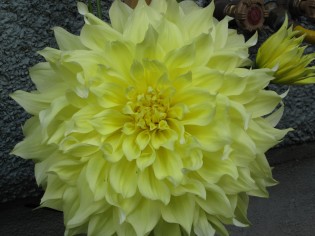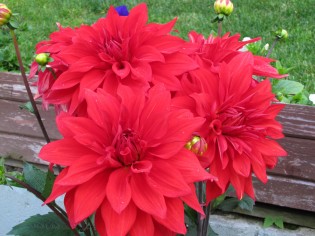Delightful Dahlias

Through years of hybridizing, there are so many different flower types, colours and sizes that there is sure to e one to fit any landscape. They make beautiful garden plants as well as container plants.
Dahlias can be grown from seed, but are most commonly and successfully grown from tubers which are now available in the garden centres.
To get a head start on the season, plant the tubers indoors now so that the plants will be established and well on their way when it comes time to place them outdoors in late May after all threat of frost has passed.
To start Dahlias indoors, choose a pot that will comfortably hold the tuber. Using a fibre or peat pot will make it less stressful on the plant when it comes time to plant outdoors as the whole container, plant and all, is planted into the soil resulting in no disturbance to the roots.
When planting, hold the tuber right side up in the pot ad fill the pot with a good quality potting soil, leaving the top of the tuber even with the surface of the soil. Once it has been planted, give it a through watering, and then place it in a warm sunny location, such as a south facing window. Let the soil go slightly dry between watering as you don’t want the tuber to rot due to too much moisture. Soon you will see growth appearing from the tuber, and at this time, you can start fertilizing the plant with a plant starter fertilizer such as 10-52-10 to help get a good root system started.
After a couple of applications of 10-52-10, switch to an all purpose fertilizer such as 20-20-20.
To produce a bushy compact plant, pinch out the centre of the plant after is has formed three sets of leaves which will cause it to branch out.
A couple of weeks before you are ready to set the plant outdoors, harden it off by placing it outdoors during the day and bringing it in at night, so that it can get used to the outdoor temperatures. Dahlias have very poor frost tolerance, so caution should be used when deciding to leave the plant outdoors for the summer.
Choose a sunny location to plant the dahlia, but avoid extreme hot midday heat. Keep them evenly watered, not letting them go dry, but not letting them get too wet either. Fertilize weekly with a flowering plant fertilizer such as 12-36-12 and remove the finished blooms as they appear, allowing the plant’s energy to go towards producing new flowers.
Dahlia tubers can be dug up and saved from one year to the next. In the fall, after the first frost has blackened the foliage, cut the foliage back to 15 cm from the tuber and carefully dig up the tuber, shaking off any excess soil. You will probably notice the tuber has grown more tubers from when it was first planted, so try to keep them all intact for now.
Let the tuber air dry for a few hours outside in the sun and then bring it indoors. You want the moisture to drain from the neck of the stem, so place the tuber upside down for a few weeks in an area that is above freezing and airy. When the neck of the stem is dry, the tuber is ready to store by labelling it and placing it in a container or bag filled with vermiculite, dry sand or peat moss. Store it where the temperature is 5-8 Celsius. Every few weeks check the tuber to see if it is still healthy and if you see any rot, remove the infected area immediately and treat the healthy part of the tuber with sulfur to prevent the rot from spreading. You also want to make sure that the tuber does not get too dry. If this becomes a problem, remove it from the storage container and give it a slight mist of water and put it back in storage.
The tubers are taken out of storage in March and can be divided by using a sharp knife. When dividing, make sure that each piece has a small portion of the stem on it and at least one eye, which is where the new plant will form.
-Jos
Jos Van Hage owns and operates two Art Knapp Home and Garden Centres in Prince George:
- Highway 16 west at Kimball Road
- Highway 97 north at Northwood Pulpmill Road


Comments
You left out the most delicious part of dahlias . They were developed by the Aztecs for food . Both pretty and edible .
Comments for this article are closed.